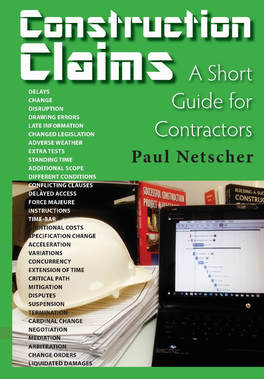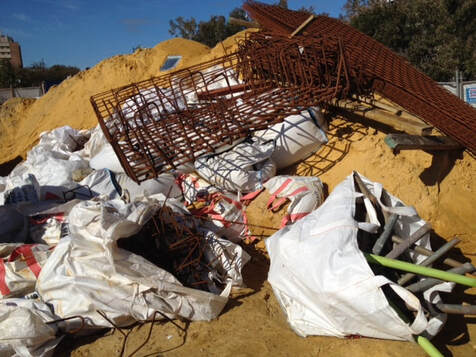 Claims are an inevitable process on most construction projects – there will be changes and delays. Yet some projects seem to have multiple claims and delays. A recent study by KPMG found more than 70% of the respondents reported that their projects increased by more than 10%, and 75% experienced delays of more than 10% on their timeline. But it isn’t just clients who receive delay and cost claims from their contractors, but also contractors who receive claims from their subcontractors. Unfortunately many projects end in lengthy, acrimonious, legal disputes between owners and managing contractors, and between contractors and their subcontractors. Frequently there are no winners in these situations – except of course the lawyers. The outcome of these variation claims is the inevitable increase in costs and delays in the project completion. But there are other impacts which include:
How to avoid variation claims on construction projects
Dealing with claims
This article was first published on the ClockShark website. To visit this website and continue reading the article click on the link above.
Please share this post To read more about the author’s books and find out where you can purchase them visit the pages on this website by clicking the links below: 'Successful Construction Project Management: The Practical Guide' 'Building a Successful Construction Company: The Practical Guide' 'Construction Claims: A Short Guide for Contractors' 'Construction Project Management: Tips and Insights' 'Construction Management: From Project Concept to Completion' 'Construction Book reviews' To read more about the author visit the page 'Paul Netscher' Want to contact Paul Netscher please enter your details on 'Contacts' Find out how Paul Netscher can help you
0 Comments
Most construction projects hire some, or all, of their construction equipment. These items could be portable electric tools, through to monster bulldozers and excavators. Sometimes the item is only required for a couple of days (even a few hours), while other equipment is required for the duration of the project. On large earthmoving projects hired equipment could make up some 40% of the project costs, so even small savings can make a difference to the project’s profits. What to check for when hired equipment arrives on your project The task of receiving equipment deliveries is often left to a person who has not been told what to look for. Things to check when hired equipment arrives on the project include:
Where the item is supplied with an operator, it’s important to check that the operator has all the correct licenses to operate the equipment. The operator should attend a project-specific introduction or induction so that they are aware of the rules and the hazards of the project before they start working. Understanding the conditions in the hire agreement Often items of equipment are hired, but the project team has not read the terms of the hire agreement, which can be fairly stringent. The terms should include:
....Continue Reading...... This article was first published on the ClockShark website. To visit this website and continue reading the article click on the link above.
Please share this post To read more about the author’s books and find out where you can purchase them visit the pages on this website by clicking the links below: 'Successful Construction Project Management: The Practical Guide' 'Building a Successful Construction Company: The Practical Guide' 'Construction Claims: A Short Guide for Contractors' 'Construction Project Management: Tips and Insights' 'Construction Management: From Project Concept to Completion' 'Construction Book reviews' To read more about the author visit the page 'Paul Netscher' Want to contact Paul Netscher please enter your details on 'Contacts' Find out how Paul Netscher can help you I’m sure every one of you are putting off tidying some part of your house. Whether it’s the garage, your clothes closet, your work room, or the garden shed. I’m sure there’s some part of the house where you take one look, then walk away, leaving it for another day. In the meantime the thought of all that mess hangs over you, and you’ve always got it nagging at the back of your mind. Then, when you finally get the courage and jump in to sort the junk, it’s often easier than you thought it would be. Sure, there are always some tough decisions, like throwing out those items you remember fondly wearing, but you haven’t worn in ages because they probably don’t fit anymore. You’ll probably find some junk that you’ve been hoarding for years, convinced that it will be some use one day. Some of you who are savvy may even turn some of that unwanted junk into cash by offering it on eBay or Craigslist. Hauling some of the better clothes to the local charity store can be immensely satisfying – cleaning out a room in your house and donating to a good cause is really good for your soul. The important thing is that as long as the problem remains unsolved, it’s like this dark cloud hanging over us every day. Some of you probably have rooms, cupboards or drawers in your house that you are too scared to even open. But, once the mess is tidied and rid of junk, it’s a tremendous relief and suddenly you are free to open that room, cupboard or drawer. The amazing thing is that once you set your mind to the task of clearing, and you are committed to that task, it usually gets done much quicker than you imagined. Of course, there are some who will make half-hearted attempts to clear the clutter, then give up before long – often leaving more of a mess than before. Those half-hearted attempts waste time and energy, but more importantly they make the problem seem even bigger than it actually is. Are there unresolved problems on your construction projectSo it is with some construction projects – they’re in a mess, and often sinking deeper. Yet, some of us avoid getting stuck in and sorting the project out. We kind of skirt the issues, hoping that miraculously the project is going to sort itself out. Well guess what, just like that junk pile at home isn’t going to sort itself out on its own, your project’s not going to sort itself out without intervention and commitment from you. Indeed, like some of you who avoid opening some rooms, cupboards or drawers in your home, I’ve known some managers that have avoided visiting their projects that were in trouble because they couldn’t face the problems. Of course this solves nothing. Certainly, sometimes some projects have multiple problems, when things start going wrong it often snowballs. Where to start? Well, like sorting that room piled with junk you have to start somewhere. More importantly you have to be committed to sorting things out, that means spending time on the project to understand the underlying causes of the problems. You can’t think that a half hour here and there will make much of an impression. Nor should you be tempted to chuck everything into the trash and start from scratch again. You might be throwing useful stuff into the trash. Some bosses fly in yelling at everyone and firing anyone they think is the problem, and often they leave the project in more of a mess than before. Like that room that’s a mess, start sorting from one end. Trash what is junk. Rearrange what should be kept. Put things in an orderly place. Don’t get distracted. Don’t run away when things get too hard. Of course, hard decisions sometimes have to be made. Don’t shy away from making them. If someone isn’t performing they need to shape-up or ship-out. But, some people may be better deployed elsewhere, they may be more suited on a different project. Of course, don’t just pass on poor people to another project. It’s kind of like sending your broken shoes to the charity shop, simply passing your problem to someone else who ultimately has to trash the item. Rather look to passing the person on to somewhere they could be better suited, kind of like passing on that jacket that’s perfectly good but doesn’t fit you anymore, to the local charity shop. Sometimes you have to spend money to fix that problem. Like when you are tidying that room at home you may have to purchase new shelving and racks, maybe even re-configuring your cupboard completely so that everything is easily accessible. So too, when sorting out our projects we sometimes have to bring in additional resources to help out. Of course, it is always easy to play the blame game. “It’s not my mess”, “It’s a difficult client” and the favorite, “it’s the estimator’s fault”. Well blaming someone doesn’t solve the problem. Deal with the problem, sort it out. Rather apply your mind and energy to solving the problem than wasting time and energy blaming others. It’s just as easy to find excuses for not sorting out the mess. “I don’t have the time”, is an all too familiar excuse. Or, there’s always the delay tactic, “I’ll have more time next week”. Well, next week will come and go and you still won’t have the time, and the mess will have gotten worse. Make the time now to sort out the problems and mess. The important thing is don’t wait until your project is in a total mess before you start sorting it out. When a problem arises, find the reason, fix the problem as well as the underlying cause so a similar problem doesn’t occur. Again, kind of like that room at home, maybe the reason things are on the floor is that there’s insufficient storage. So create more storage, then pick the stuff up and pack it neatly. Prevent problems on your construction projectBetter still, don’t let you project get into a mess in the first place. If it’s planned properly from the start, and if everyone approaches the project logically and orderly, then many problems can be avoided. If hard decisions are made as needed, then problems can be avoided. If problems are dealt with when they arise they won’t snowball. Exactly in your own homes, if you have a plan and a place for everything, and stick to that plan, ensuring that everyone else in your house follows that plan, then everything will have its rightful place and should be returned there. When something is broken it either gets fixed immediately or it gets trashed. It’s pointless keeping that jacket that no longer fits in the forlorn hope that one day you’re going to shrink a few sizes and it will fit you again – it probably won’t happen, and if it ever does happen the jacket will be long out of fashion. Do not wait to solve issues on your construction projectOnce a mess has been tidied it’s immensely satisfying, its like a whole weight has been lifted from your shoulders. Suddenly it’s pleasant to enter that room, or visit that project. So, if your project is in a mess, make the time to sort it out. Have a strategy and a plan. Break the problems into small parts that can be more easily dealt with. Understand the underlying reasons for the mess. Solve them one by one. Don’t let the whole messy situation overwhelm you. Be bold, make the hard decisions when you have to. Salvage what you can salvage. Trash what must be trashed. Create order from the chaos. Go out today with a mission to resolve those problems, to tidy those messy projects. #constructionmanagement #constructionprojectmanagement #contractors #constructionindustry "Go out today with a mission to resolve those problems, to tidy those messy projects." Do you want to learn how to manage construction projects successfullyThis article was first published on the ClockShark website. To visit this website and continue reading the article click on the link above.
Please share this post To read more about the author’s books and find out where you can purchase them visit the pages on this website by clicking the links below: 'Successful Construction Project Management: The Practical Guide' 'Building a Successful Construction Company: The Practical Guide' 'Construction Claims: A Short Guide for Contractors' 'Construction Project Management: Tips and Insights' 'Construction Management: From Project Concept to Completion' 'Construction Book reviews' To read more about the author visit the page 'Paul Netscher' Want to contact Paul Netscher please enter your details on 'Contacts' Find out how Paul Netscher can help you |
Archives
June 2024
Note: We welcome genuine comments, especially comments that add additional information to the subject matter in the article. We however reserve the right to remove inappropriate comments, which includes comments that have nothing to do with the subject, comments that include inappropriate language, and comments that are an advertisement for a product or company, or which include an advertising link. Comments must be in English. We will not enter into discussion on why a particular comment was removed.
CategoriesCopyright 2016 - The attached articles cannot be reproduced for commercial purposes without the consent of the author.
The opinions expressed in the attached articles are those of the writer. It should be noted that projects are varied and different laws and restrictions apply which depend on the location of the contractor and the project. It's important that the reader uses the supplied information taking cognisance of their particular circumstances. The writer assumes no responsibility or liability for any loss of any kind arising from the reader using the information or advice contained herein. "I have what I consider some of the best books on construction management."
Books are available from: Amazon.com Amazon.co.uk takealot.com kalahari.com Amazon.in Amazon.de Amazon.fr Amazon.it Amazon.com.au Powell's Fishpond uread bokus Amazon.ca Amazon.es Other retail stores Available in paperback or on Kindle "28 YEARS OF CONSTRUCTION PROJECT MANAGEMENT EXPERIENCE, DEVELOPING SUCCESSFUL CONSTRUCTION PROJECT MANAGERS AND BUILDING SUCCESSFUL CONSTRUCTION COMPANIES"
|





 RSS Feed
RSS Feed




